Showing Spotlights 193 - 200 of 240 in category All (newest first):
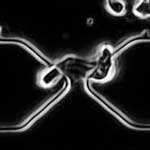 Miniaturizing traditional laboratory assays to automated lab-on-a-chip devices holds tremendous potential for enabling multiplex, efficient, cost-effective and accurate pathogen sensing systems for both security and medical applications. These sensors could be used to detect bacteria such as E. coli and Salmonella, but also other pathogens that could be used for bioterrorism. Traditional identification methods required time intensive cell culturing processes but novel pathogen sensors based on nanomaterials are promising vastly improved and speedy detection technologies. A recent example is a label-free sensor chip assembled from peptide nanotubes that enables the electrical detection of viruses with an extremely low detection limit. This could lead to compact super-sensitive pathogen detection chips for point of care applications that have a high tolerance against false-positive signals.
Miniaturizing traditional laboratory assays to automated lab-on-a-chip devices holds tremendous potential for enabling multiplex, efficient, cost-effective and accurate pathogen sensing systems for both security and medical applications. These sensors could be used to detect bacteria such as E. coli and Salmonella, but also other pathogens that could be used for bioterrorism. Traditional identification methods required time intensive cell culturing processes but novel pathogen sensors based on nanomaterials are promising vastly improved and speedy detection technologies. A recent example is a label-free sensor chip assembled from peptide nanotubes that enables the electrical detection of viruses with an extremely low detection limit. This could lead to compact super-sensitive pathogen detection chips for point of care applications that have a high tolerance against false-positive signals.
Dec 2nd, 2008
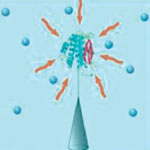 Genomics and proteomics, the studies of genes and proteins, provide the underlying basis for many advances in drug development and effective treatments of diseases. These studies heavily rely on unveiling the behavior of a single DNA or protein in an investigative sample. You could compare this challenge to somehow finding, then catching and monitoring a particular fish in a vast ocean. The scientific term for 'catching the fish' is 'immobilization' - a powerful technique for the study of biochemical systems that allows for the continuous observation of dynamic behavior of a chosen target. Immobilization methods anchor the to be observed molecule onto a surface in order to restrict it from escaping the observation volume. Researchers have now developed a new platform which consists of a carbon nanotube nanoneedle for capturing, isolating and measuring the activity of miniscule amounts of proteins.
Genomics and proteomics, the studies of genes and proteins, provide the underlying basis for many advances in drug development and effective treatments of diseases. These studies heavily rely on unveiling the behavior of a single DNA or protein in an investigative sample. You could compare this challenge to somehow finding, then catching and monitoring a particular fish in a vast ocean. The scientific term for 'catching the fish' is 'immobilization' - a powerful technique for the study of biochemical systems that allows for the continuous observation of dynamic behavior of a chosen target. Immobilization methods anchor the to be observed molecule onto a surface in order to restrict it from escaping the observation volume. Researchers have now developed a new platform which consists of a carbon nanotube nanoneedle for capturing, isolating and measuring the activity of miniscule amounts of proteins.
Oct 3rd, 2008
 Artificial skin already exists that can detect pressure and recently, thanks to carbon nanotube rubber, it now even is stretchable. Then there is stretchable artificial skin that is used, for instance, to provide grafts for human burns victims, but it is insensitive to heat and pressure. Skin-like sensitivity, or the capability to recognize tactile information, will be an essential feature of future generations of robots. Of course you could also dream up some sci-fi scenarios where artificial electronic skin vastly enhances human perception and performance. The development of electronic skin requires high-performance tactile sensors that mimic human skin in terms of touch sensation over a large area, high flexibility, resolution, and sensitivity comparable to a human finger, as well as ease of signal extraction for speed and implementation. A recent review article summarizes the current state of developing artificial touch, an area where significant progress has been made over the past few years.
Artificial skin already exists that can detect pressure and recently, thanks to carbon nanotube rubber, it now even is stretchable. Then there is stretchable artificial skin that is used, for instance, to provide grafts for human burns victims, but it is insensitive to heat and pressure. Skin-like sensitivity, or the capability to recognize tactile information, will be an essential feature of future generations of robots. Of course you could also dream up some sci-fi scenarios where artificial electronic skin vastly enhances human perception and performance. The development of electronic skin requires high-performance tactile sensors that mimic human skin in terms of touch sensation over a large area, high flexibility, resolution, and sensitivity comparable to a human finger, as well as ease of signal extraction for speed and implementation. A recent review article summarizes the current state of developing artificial touch, an area where significant progress has been made over the past few years.
Sep 30th, 2008
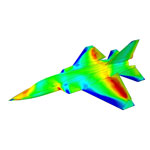 'Smart' is the key buzz word used by materials engineers when they describe the future of coatings, textiles, building structures, vehicles and just any material that you can think of. Materials are made 'smart' when they are engineered to have properties that change in a controlled manner under the influence of external stimuli such as mechanical stress, temperature, humidity, electric charge, magnetic fields etc. Smart materials have some form of sensor capability that detects a change in the material or its environment that then triggers some kind of action. Not only for use in smart materials but as general sensor materials, especially for monitoring large areas, the development of materials that act as 'chemical paints' - or coatings - by responding to a (bio)chemical parameter with a change in their optical properties has developed into an exciting new field. In a typical application, the object of interest is painted and the color or fluorescence of the paint is monitored by methods of optical imaging. This technique represents a simple but exciting new technology to monitor (bio)chemical and even physical parameters over relatively large areas and in real time without having to look at only a minute sample through a microscope.
'Smart' is the key buzz word used by materials engineers when they describe the future of coatings, textiles, building structures, vehicles and just any material that you can think of. Materials are made 'smart' when they are engineered to have properties that change in a controlled manner under the influence of external stimuli such as mechanical stress, temperature, humidity, electric charge, magnetic fields etc. Smart materials have some form of sensor capability that detects a change in the material or its environment that then triggers some kind of action. Not only for use in smart materials but as general sensor materials, especially for monitoring large areas, the development of materials that act as 'chemical paints' - or coatings - by responding to a (bio)chemical parameter with a change in their optical properties has developed into an exciting new field. In a typical application, the object of interest is painted and the color or fluorescence of the paint is monitored by methods of optical imaging. This technique represents a simple but exciting new technology to monitor (bio)chemical and even physical parameters over relatively large areas and in real time without having to look at only a minute sample through a microscope.
Sep 26th, 2008
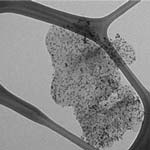 Carbon nanomaterials have been extensively used in electroanalysis, and the most common forms are spherical fullerenes, cylindrical nanotubes, and carbon fibers and blacks. Since the discovery that individual carbon nanotubes (CNTs) can be used as nanoscale transistors, researchers have recognized their outstanding potential for electronic detection of biomolecules in solution, possibly down to single-molecule sensitivity. To detect biologically derived electronic signals, CNTs are often functionalized with linkers such as proteins and peptides to interface with soluble biologically relevant targets. Now, for the first time, scientists have tested nanometal decorated graphene (actually graphite nanoplatelets, a thickness of 10 nm would contain approximately 30 graphene sheets, considering an interlayer spacing of 0.335 nm) in biosensor application. As it turned out, this novel biosensor is among the best reported to date in both sensing performance and production cost.
Carbon nanomaterials have been extensively used in electroanalysis, and the most common forms are spherical fullerenes, cylindrical nanotubes, and carbon fibers and blacks. Since the discovery that individual carbon nanotubes (CNTs) can be used as nanoscale transistors, researchers have recognized their outstanding potential for electronic detection of biomolecules in solution, possibly down to single-molecule sensitivity. To detect biologically derived electronic signals, CNTs are often functionalized with linkers such as proteins and peptides to interface with soluble biologically relevant targets. Now, for the first time, scientists have tested nanometal decorated graphene (actually graphite nanoplatelets, a thickness of 10 nm would contain approximately 30 graphene sheets, considering an interlayer spacing of 0.335 nm) in biosensor application. As it turned out, this novel biosensor is among the best reported to date in both sensing performance and production cost.
Sep 8th, 2008
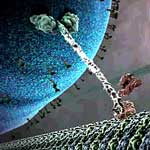 Borrowing from nature's micro- and nanoscale propulsion systems, nanotechnology researchers have successfully used motor proteins to transport nanosized cargo in molecular sorting and nano-assembly devices. In so-called gliding assays, surface-attached motors propel cytoskeletal filaments, which in turn transport a cargo. However, cargo and motors both attach to the filament lattice and will affect each other. While an effect of cargo loading on transport speed has been described before, it has never been explained very well. To study this effect, scientists in Germany have observed single kinesin-1 molecules on streptavidin coated microtubules. They found that individual kinesin-1 motors frequently stopped upon encounters with attached streptavidin molecules. This work helps to understand the interactions of kinesin-1 and obstacles on the microtubule surface. An interesting, possibly even more important side result is that this understanding will not only help to optimize transport assays, balancing speed and cargo-loading, but can be used as a novel method for the detection of proteins as well.
Borrowing from nature's micro- and nanoscale propulsion systems, nanotechnology researchers have successfully used motor proteins to transport nanosized cargo in molecular sorting and nano-assembly devices. In so-called gliding assays, surface-attached motors propel cytoskeletal filaments, which in turn transport a cargo. However, cargo and motors both attach to the filament lattice and will affect each other. While an effect of cargo loading on transport speed has been described before, it has never been explained very well. To study this effect, scientists in Germany have observed single kinesin-1 molecules on streptavidin coated microtubules. They found that individual kinesin-1 motors frequently stopped upon encounters with attached streptavidin molecules. This work helps to understand the interactions of kinesin-1 and obstacles on the microtubule surface. An interesting, possibly even more important side result is that this understanding will not only help to optimize transport assays, balancing speed and cargo-loading, but can be used as a novel method for the detection of proteins as well.
Sep 4th, 2008
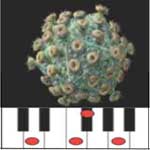 Detecting the presence of a given substance at the molecular level, down to a single molecule, remains a considerable challenge for many nanotechnology sensor applications that range from nanobiotechnology research to environmental monitoring and antiterror or military applications. Currently, chemical functionalization techniques are used to specify what a nanoscale detector will sense. For biological molecules, this might mean developing an antibody/antigen pair, or an alternative synthetically generated ligand. For chemical gases, it is much more challenging to develop the right 'glue' that sticks a given gas to a substrate. The advantage of spectroscopic techniques such as Raman, infrared, and nuclear magnetic resonance spectroscopy is that they are label-free, i.e. they require no preconditioning in order to identify a given analyte. They are also highly selective, capable of distinguishing species that are chemically or functionally very similar. On the downside, spectroscopic methods face enormous challenges in measuring dilute concentrations of an analyte and generally involve the use of large, expensive equipment. This article describes a novel chemical detection technique called nanomechanical resonance spectroscopy.
Detecting the presence of a given substance at the molecular level, down to a single molecule, remains a considerable challenge for many nanotechnology sensor applications that range from nanobiotechnology research to environmental monitoring and antiterror or military applications. Currently, chemical functionalization techniques are used to specify what a nanoscale detector will sense. For biological molecules, this might mean developing an antibody/antigen pair, or an alternative synthetically generated ligand. For chemical gases, it is much more challenging to develop the right 'glue' that sticks a given gas to a substrate. The advantage of spectroscopic techniques such as Raman, infrared, and nuclear magnetic resonance spectroscopy is that they are label-free, i.e. they require no preconditioning in order to identify a given analyte. They are also highly selective, capable of distinguishing species that are chemically or functionally very similar. On the downside, spectroscopic methods face enormous challenges in measuring dilute concentrations of an analyte and generally involve the use of large, expensive equipment. This article describes a novel chemical detection technique called nanomechanical resonance spectroscopy.
Aug 27th, 2008
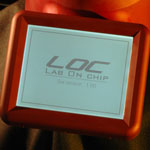 The term biosensing relates to systems that include electronic, photonic, biologic, chemical and mechanical means for producing signals that can be used for the identification, monitoring or control of biological phenomena. The resulting biosensors are devices that employ biological components such as proteins to provide selectivity and/or amplification for the detection of biochemical materials for use in medical diagnostics, environmental analysis or chemical and biological warfare agent detection. Surface plasmon resonance (SPR) has become the technology of choice for label-free detection of proteins and other biomolecules. SPR is based on the excitation of a surface plasmon at the interface between a dielectric and a thin layer of metal, typically gold. Once the sample is covered with the nanostructured gold layer (or another suitable metal), the surface absorbs light at certain wavelength. The absorption maximum is influenced by the refractive index of the fluid at the gold surface. This effect is called localized surface plasmon resonance (LSPR) and it is used for detection of presence of biomolecules, such as specific proteins.
The term biosensing relates to systems that include electronic, photonic, biologic, chemical and mechanical means for producing signals that can be used for the identification, monitoring or control of biological phenomena. The resulting biosensors are devices that employ biological components such as proteins to provide selectivity and/or amplification for the detection of biochemical materials for use in medical diagnostics, environmental analysis or chemical and biological warfare agent detection. Surface plasmon resonance (SPR) has become the technology of choice for label-free detection of proteins and other biomolecules. SPR is based on the excitation of a surface plasmon at the interface between a dielectric and a thin layer of metal, typically gold. Once the sample is covered with the nanostructured gold layer (or another suitable metal), the surface absorbs light at certain wavelength. The absorption maximum is influenced by the refractive index of the fluid at the gold surface. This effect is called localized surface plasmon resonance (LSPR) and it is used for detection of presence of biomolecules, such as specific proteins.
Aug 4th, 2008
 Miniaturizing traditional laboratory assays to automated lab-on-a-chip devices holds tremendous potential for enabling multiplex, efficient, cost-effective and accurate pathogen sensing systems for both security and medical applications. These sensors could be used to detect bacteria such as E. coli and Salmonella, but also other pathogens that could be used for bioterrorism. Traditional identification methods required time intensive cell culturing processes but novel pathogen sensors based on nanomaterials are promising vastly improved and speedy detection technologies. A recent example is a label-free sensor chip assembled from peptide nanotubes that enables the electrical detection of viruses with an extremely low detection limit. This could lead to compact super-sensitive pathogen detection chips for point of care applications that have a high tolerance against false-positive signals.
Miniaturizing traditional laboratory assays to automated lab-on-a-chip devices holds tremendous potential for enabling multiplex, efficient, cost-effective and accurate pathogen sensing systems for both security and medical applications. These sensors could be used to detect bacteria such as E. coli and Salmonella, but also other pathogens that could be used for bioterrorism. Traditional identification methods required time intensive cell culturing processes but novel pathogen sensors based on nanomaterials are promising vastly improved and speedy detection technologies. A recent example is a label-free sensor chip assembled from peptide nanotubes that enables the electrical detection of viruses with an extremely low detection limit. This could lead to compact super-sensitive pathogen detection chips for point of care applications that have a high tolerance against false-positive signals.
 Subscribe to our Nanotechnology Spotlight feed
Subscribe to our Nanotechnology Spotlight feed





